Report on Leadership and Management in M&S Retail Operations
VerifiedAdded on 2020/07/23
|13
|4112
|26
Report
AI Summary
This report provides an in-depth analysis of leadership and management practices within M&S, a prominent retail outlet specializing in clothing, home products, and luxury food. It begins by defining and differentiating the roles and characteristics of leaders and managers, highlighting their distinct approaches to vision setting, change management, and operational execution. The report then delves into the application of leadership theories, such as situational leadership, action-centered leadership, contingency models, and system leadership, within the M&S context. Furthermore, it explores key approaches to operations management, including system and dynamic approaches, and examines the roles of leaders and managers in optimizing these processes. The report emphasizes the importance of operations management in achieving business objectives, discussing its value in enhancing efficiency and product development. Finally, it addresses factors influencing decision-making and the broader impact on the business environment and community, concluding with a critical evaluation of leadership and management strategies at M&S.
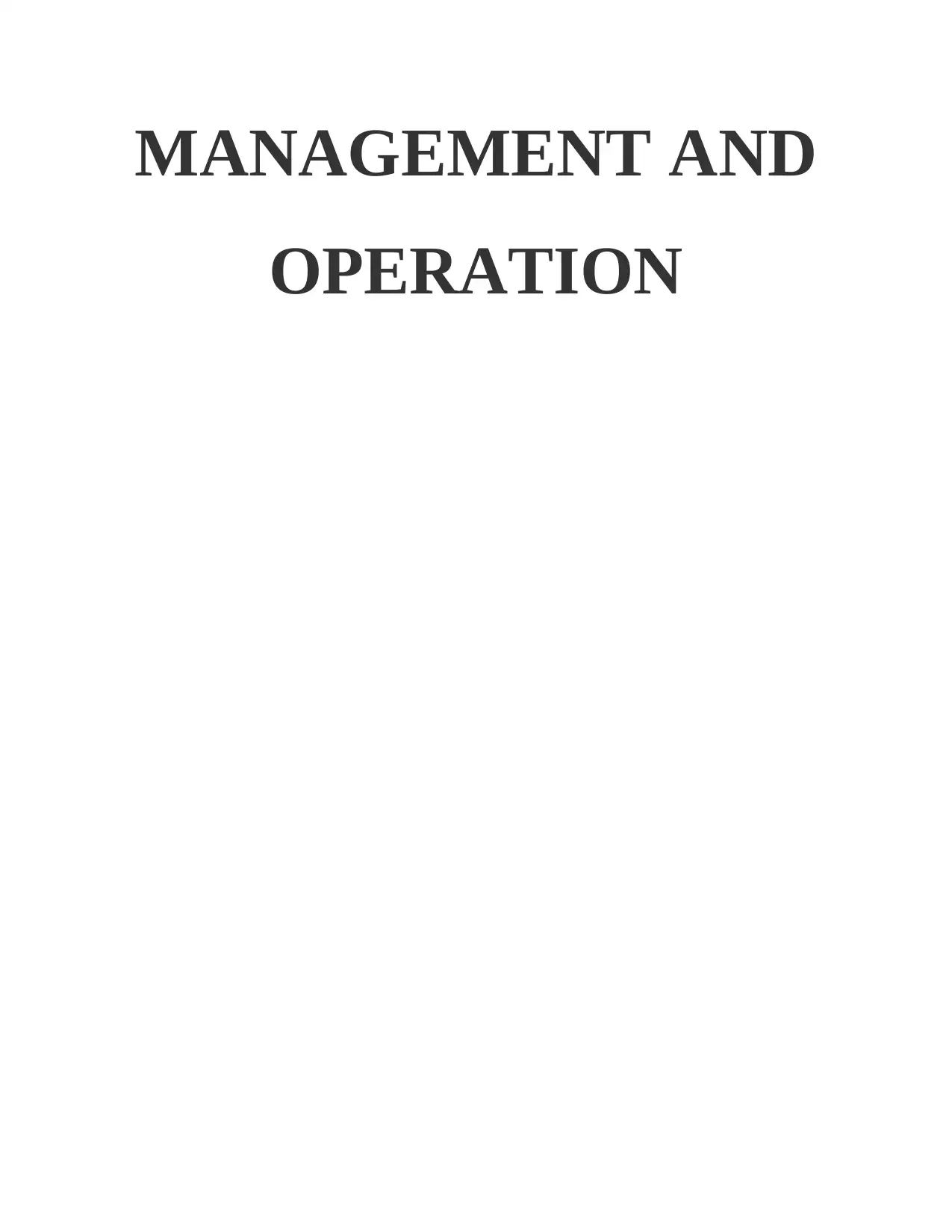
MANAGEMENT AND
OPERATION
OPERATION
Paraphrase This Document
Need a fresh take? Get an instant paraphrase of this document with our AI Paraphraser
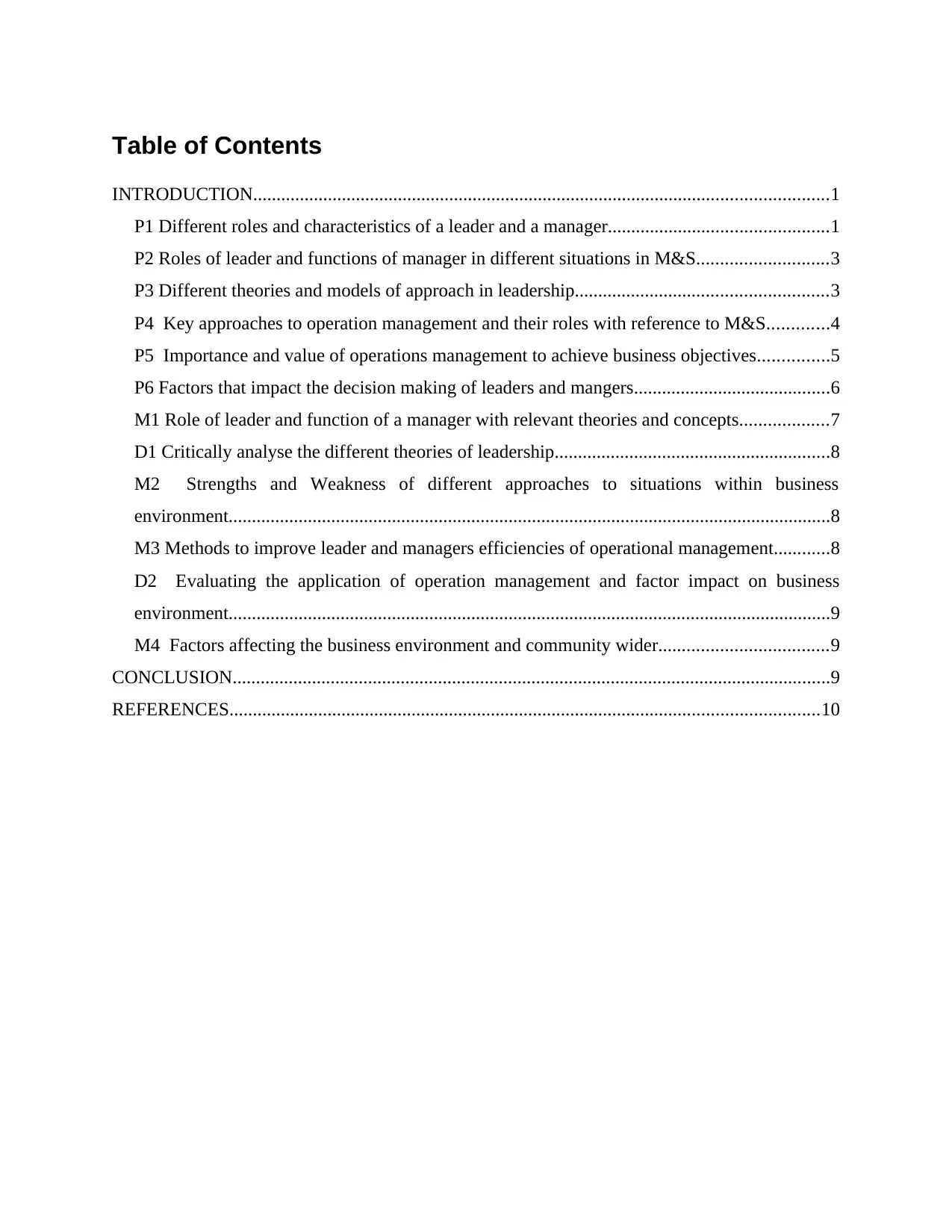
Table of Contents
INTRODUCTION...........................................................................................................................1
P1 Different roles and characteristics of a leader and a manager...............................................1
P2 Roles of leader and functions of manager in different situations in M&S............................3
P3 Different theories and models of approach in leadership......................................................3
P4 Key approaches to operation management and their roles with reference to M&S.............4
P5 Importance and value of operations management to achieve business objectives...............5
P6 Factors that impact the decision making of leaders and mangers..........................................6
M1 Role of leader and function of a manager with relevant theories and concepts...................7
D1 Critically analyse the different theories of leadership...........................................................8
M2 Strengths and Weakness of different approaches to situations within business
environment.................................................................................................................................8
M3 Methods to improve leader and managers efficiencies of operational management............8
D2 Evaluating the application of operation management and factor impact on business
environment.................................................................................................................................9
M4 Factors affecting the business environment and community wider....................................9
CONCLUSION................................................................................................................................9
REFERENCES..............................................................................................................................10
INTRODUCTION...........................................................................................................................1
P1 Different roles and characteristics of a leader and a manager...............................................1
P2 Roles of leader and functions of manager in different situations in M&S............................3
P3 Different theories and models of approach in leadership......................................................3
P4 Key approaches to operation management and their roles with reference to M&S.............4
P5 Importance and value of operations management to achieve business objectives...............5
P6 Factors that impact the decision making of leaders and mangers..........................................6
M1 Role of leader and function of a manager with relevant theories and concepts...................7
D1 Critically analyse the different theories of leadership...........................................................8
M2 Strengths and Weakness of different approaches to situations within business
environment.................................................................................................................................8
M3 Methods to improve leader and managers efficiencies of operational management............8
D2 Evaluating the application of operation management and factor impact on business
environment.................................................................................................................................9
M4 Factors affecting the business environment and community wider....................................9
CONCLUSION................................................................................................................................9
REFERENCES..............................................................................................................................10

INTRODUCTION
Operations management is term that is related in the management practices of the
business to develop the efficiency in organisational activities. To achieve the goals and
objectives of the business and to increase profitability it works by considering the business
activities and developing raw materials and labour into goods and services. By implementing
different practices in the business and strategies in the workplace it focuses to succeed and
develop the organisational practices. The practices such as controlling and designing the process
for production. It also focuses on implementation of the responsibilities to fulfil the needs and
demands of the customers and to effectively undertake the business practices and operations. To
develop products and increase productivity it works on planning, organising, directing and
controlling the overall process. The present report is based on M&S which is retail outlet and
specialises in selling clothing, home products and luxury food products headquartered in
London, United Kingdom. Moreover, the report also covers different roles and characteristics of
a leader and a manager. Analysis of different between the leader role and also explains the
managerial functions and the importance and values of operations and management to achieve
objectives of business.
P1 Different roles and characteristics of a leader and a manager
Definition of a leader: A leader is an individual who has the ability to attract others and
give guidance to achieve the objectives and goals of the organisation. He shows the path to
others like individual, team or whole organisation and influence others in a particular field and
enhances their skills and abilities to complete the given task.
Definition of a manager: The person who is appointed in the organisation to manage the given
resources and has the skills and abilities to delegate work and bring out the desired outcomes
with the available resources(Machida-Kosuga, Schaubroeck and Feltz, 2017). Person who
influences others in the organisation to complete the given task and reach organisational
objectives.
Comparison between a leader and a manager in M&S:
Leaders create a vision and manager creates objectives- Leaders inspire their followers
and create a vision for them and what they see for the future and also works to achieve
1
Operations management is term that is related in the management practices of the
business to develop the efficiency in organisational activities. To achieve the goals and
objectives of the business and to increase profitability it works by considering the business
activities and developing raw materials and labour into goods and services. By implementing
different practices in the business and strategies in the workplace it focuses to succeed and
develop the organisational practices. The practices such as controlling and designing the process
for production. It also focuses on implementation of the responsibilities to fulfil the needs and
demands of the customers and to effectively undertake the business practices and operations. To
develop products and increase productivity it works on planning, organising, directing and
controlling the overall process. The present report is based on M&S which is retail outlet and
specialises in selling clothing, home products and luxury food products headquartered in
London, United Kingdom. Moreover, the report also covers different roles and characteristics of
a leader and a manager. Analysis of different between the leader role and also explains the
managerial functions and the importance and values of operations and management to achieve
objectives of business.
P1 Different roles and characteristics of a leader and a manager
Definition of a leader: A leader is an individual who has the ability to attract others and
give guidance to achieve the objectives and goals of the organisation. He shows the path to
others like individual, team or whole organisation and influence others in a particular field and
enhances their skills and abilities to complete the given task.
Definition of a manager: The person who is appointed in the organisation to manage the given
resources and has the skills and abilities to delegate work and bring out the desired outcomes
with the available resources(Machida-Kosuga, Schaubroeck and Feltz, 2017). Person who
influences others in the organisation to complete the given task and reach organisational
objectives.
Comparison between a leader and a manager in M&S:
Leaders create a vision and manager creates objectives- Leaders inspire their followers
and create a vision for them and what they see for the future and also works to achieve
1
⊘ This is a preview!⊘
Do you want full access?
Subscribe today to unlock all pages.

Trusted by 1+ million students worldwide
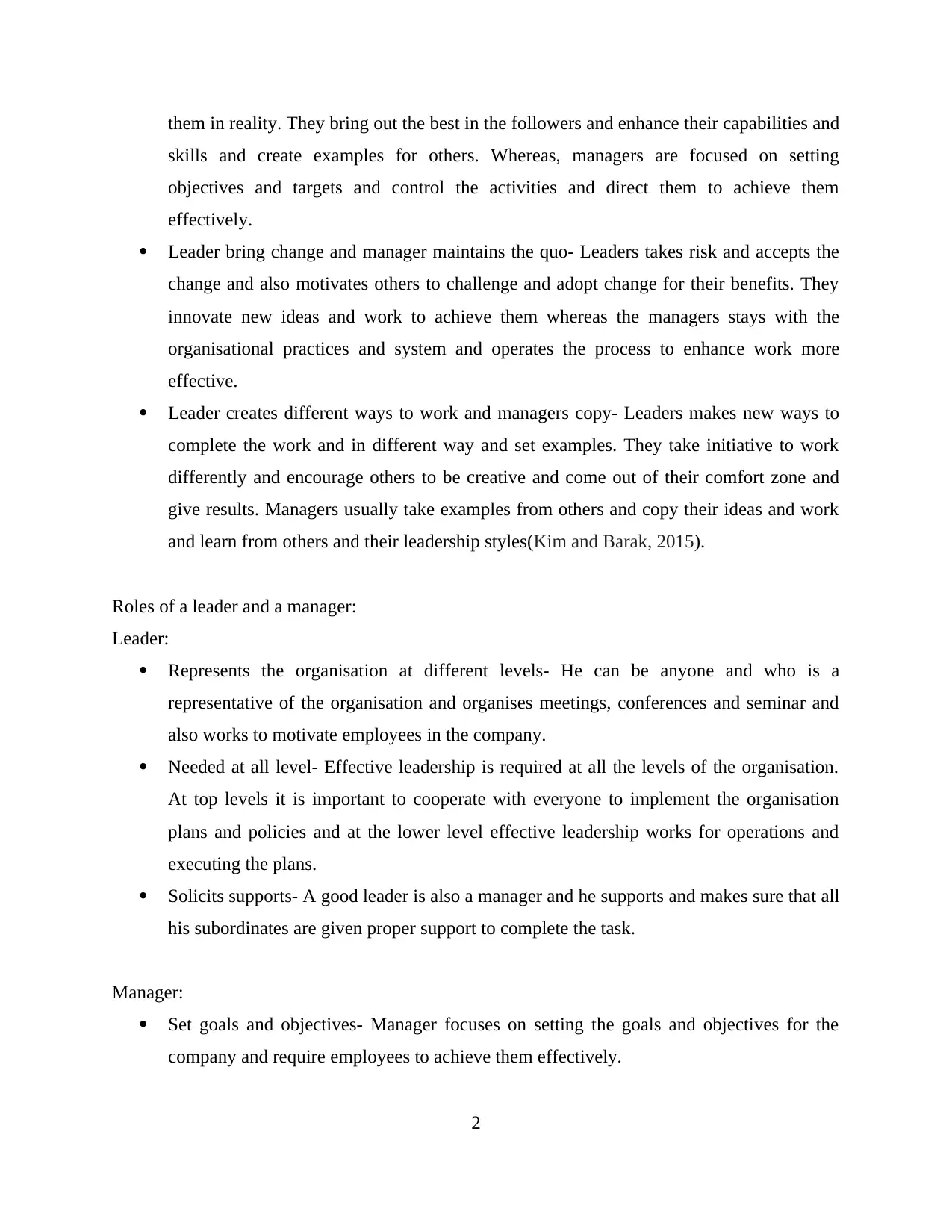
them in reality. They bring out the best in the followers and enhance their capabilities and
skills and create examples for others. Whereas, managers are focused on setting
objectives and targets and control the activities and direct them to achieve them
effectively.
Leader bring change and manager maintains the quo- Leaders takes risk and accepts the
change and also motivates others to challenge and adopt change for their benefits. They
innovate new ideas and work to achieve them whereas the managers stays with the
organisational practices and system and operates the process to enhance work more
effective.
Leader creates different ways to work and managers copy- Leaders makes new ways to
complete the work and in different way and set examples. They take initiative to work
differently and encourage others to be creative and come out of their comfort zone and
give results. Managers usually take examples from others and copy their ideas and work
and learn from others and their leadership styles(Kim and Barak, 2015).
Roles of a leader and a manager:
Leader:
Represents the organisation at different levels- He can be anyone and who is a
representative of the organisation and organises meetings, conferences and seminar and
also works to motivate employees in the company.
Needed at all level- Effective leadership is required at all the levels of the organisation.
At top levels it is important to cooperate with everyone to implement the organisation
plans and policies and at the lower level effective leadership works for operations and
executing the plans.
Solicits supports- A good leader is also a manager and he supports and makes sure that all
his subordinates are given proper support to complete the task.
Manager:
Set goals and objectives- Manager focuses on setting the goals and objectives for the
company and require employees to achieve them effectively.
2
skills and create examples for others. Whereas, managers are focused on setting
objectives and targets and control the activities and direct them to achieve them
effectively.
Leader bring change and manager maintains the quo- Leaders takes risk and accepts the
change and also motivates others to challenge and adopt change for their benefits. They
innovate new ideas and work to achieve them whereas the managers stays with the
organisational practices and system and operates the process to enhance work more
effective.
Leader creates different ways to work and managers copy- Leaders makes new ways to
complete the work and in different way and set examples. They take initiative to work
differently and encourage others to be creative and come out of their comfort zone and
give results. Managers usually take examples from others and copy their ideas and work
and learn from others and their leadership styles(Kim and Barak, 2015).
Roles of a leader and a manager:
Leader:
Represents the organisation at different levels- He can be anyone and who is a
representative of the organisation and organises meetings, conferences and seminar and
also works to motivate employees in the company.
Needed at all level- Effective leadership is required at all the levels of the organisation.
At top levels it is important to cooperate with everyone to implement the organisation
plans and policies and at the lower level effective leadership works for operations and
executing the plans.
Solicits supports- A good leader is also a manager and he supports and makes sure that all
his subordinates are given proper support to complete the task.
Manager:
Set goals and objectives- Manager focuses on setting the goals and objectives for the
company and require employees to achieve them effectively.
2
Paraphrase This Document
Need a fresh take? Get an instant paraphrase of this document with our AI Paraphraser
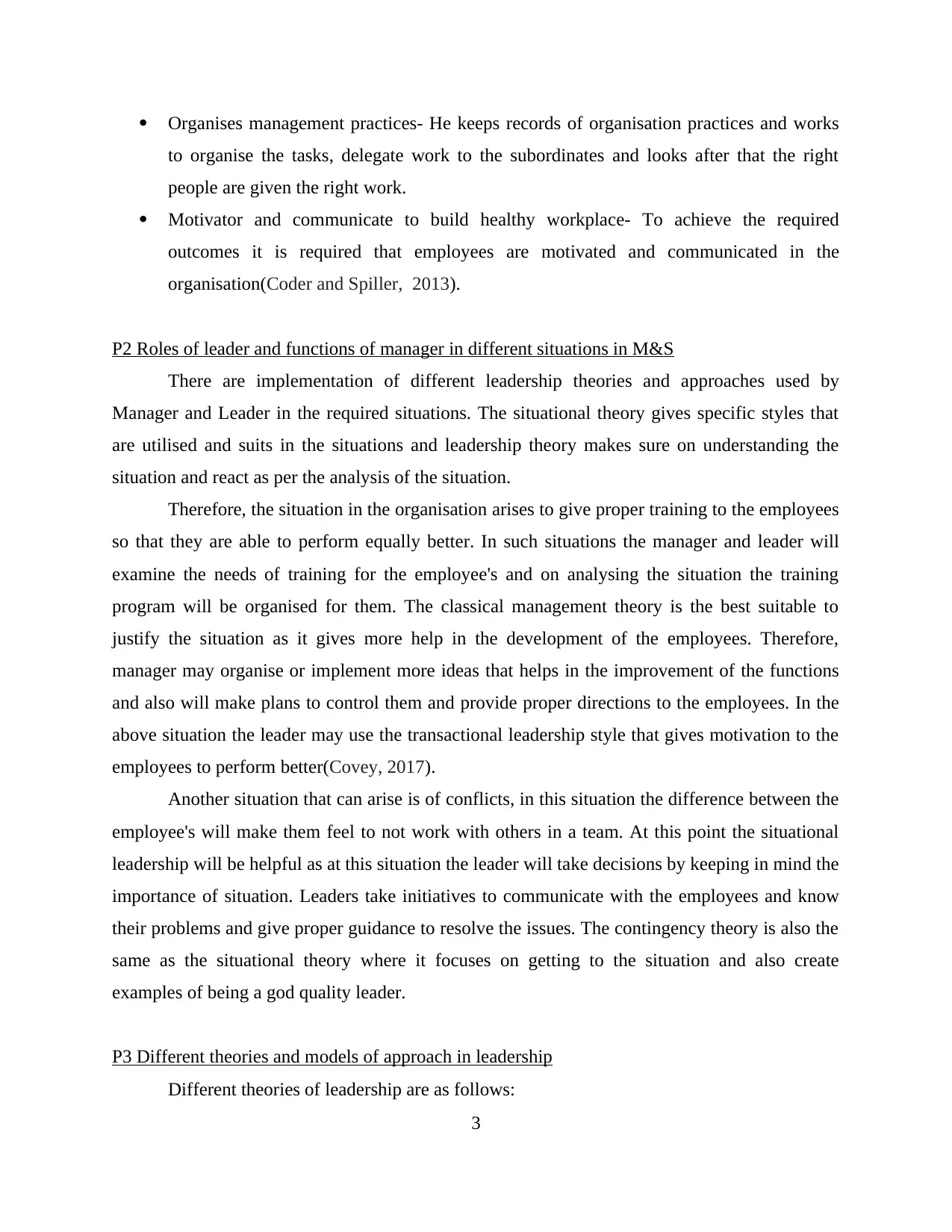
Organises management practices- He keeps records of organisation practices and works
to organise the tasks, delegate work to the subordinates and looks after that the right
people are given the right work.
Motivator and communicate to build healthy workplace- To achieve the required
outcomes it is required that employees are motivated and communicated in the
organisation(Coder and Spiller, 2013).
P2 Roles of leader and functions of manager in different situations in M&S
There are implementation of different leadership theories and approaches used by
Manager and Leader in the required situations. The situational theory gives specific styles that
are utilised and suits in the situations and leadership theory makes sure on understanding the
situation and react as per the analysis of the situation.
Therefore, the situation in the organisation arises to give proper training to the employees
so that they are able to perform equally better. In such situations the manager and leader will
examine the needs of training for the employee's and on analysing the situation the training
program will be organised for them. The classical management theory is the best suitable to
justify the situation as it gives more help in the development of the employees. Therefore,
manager may organise or implement more ideas that helps in the improvement of the functions
and also will make plans to control them and provide proper directions to the employees. In the
above situation the leader may use the transactional leadership style that gives motivation to the
employees to perform better(Covey, 2017).
Another situation that can arise is of conflicts, in this situation the difference between the
employee's will make them feel to not work with others in a team. At this point the situational
leadership will be helpful as at this situation the leader will take decisions by keeping in mind the
importance of situation. Leaders take initiatives to communicate with the employees and know
their problems and give proper guidance to resolve the issues. The contingency theory is also the
same as the situational theory where it focuses on getting to the situation and also create
examples of being a god quality leader.
P3 Different theories and models of approach in leadership
Different theories of leadership are as follows:
3
to organise the tasks, delegate work to the subordinates and looks after that the right
people are given the right work.
Motivator and communicate to build healthy workplace- To achieve the required
outcomes it is required that employees are motivated and communicated in the
organisation(Coder and Spiller, 2013).
P2 Roles of leader and functions of manager in different situations in M&S
There are implementation of different leadership theories and approaches used by
Manager and Leader in the required situations. The situational theory gives specific styles that
are utilised and suits in the situations and leadership theory makes sure on understanding the
situation and react as per the analysis of the situation.
Therefore, the situation in the organisation arises to give proper training to the employees
so that they are able to perform equally better. In such situations the manager and leader will
examine the needs of training for the employee's and on analysing the situation the training
program will be organised for them. The classical management theory is the best suitable to
justify the situation as it gives more help in the development of the employees. Therefore,
manager may organise or implement more ideas that helps in the improvement of the functions
and also will make plans to control them and provide proper directions to the employees. In the
above situation the leader may use the transactional leadership style that gives motivation to the
employees to perform better(Covey, 2017).
Another situation that can arise is of conflicts, in this situation the difference between the
employee's will make them feel to not work with others in a team. At this point the situational
leadership will be helpful as at this situation the leader will take decisions by keeping in mind the
importance of situation. Leaders take initiatives to communicate with the employees and know
their problems and give proper guidance to resolve the issues. The contingency theory is also the
same as the situational theory where it focuses on getting to the situation and also create
examples of being a god quality leader.
P3 Different theories and models of approach in leadership
Different theories of leadership are as follows:
3

Situational leadership- In this leadership theory it states that it is not based on any
specific approach. It is believed that a leader needs to consider a theory and adopt a
leadership style that can make a good team and also consider their needs. Therefore, the
decision-making power of leader in the organisation depends on the different members
who will be affected by it. In the case of M&S the leader delegates the work to his
subordinates as their skills and abilities and also provide support to his team members. To
get the work done it is also required to have a good communication with the
employees(Rosemann and vom Brocke, 2015).
Action centred leadership- This covers a large scope of leadership and in the modern
work culture this style is best to use for the organisation. In M&S the company works in
the clothing and retail outlets and also they need to develop strategies to work together to
give proper feedbacks. It is also necessary for them to look after the demand of the
market and the suppliers as well. It helps them to achieve their goals and objectives and
manage team effectively. Therefore, the duties are assigned according to the skills and
abilities and requirement of the situation and the manager at last monitors and
coordinates the workload.
Contingency model- This model is the best suitable for the working of M&S, the
effectiveness and success of the company is derived from its work culture and its
leadership style. It is seen from this that it is task oriented and also relationship oriented
and is beneficial for the organisation to develop these situations. For example, to provide
the best products and keeping the demand of the market in consideration it is required to
have a good leader and employee relations and its structure is also developed as per the
requirement(Kerzner, 2013).
System leadership model- The leadership style of a leader gives the organisation structure
according to its transformation. In M&S leader provide every employee with the mission,
vision of the company and to develop healthy relationship. To make sure that employee's
work effectively there is a need to build trust between them.
P4 Key approaches to operation management and their roles with reference to M&S
Operation management is important in the process of organisation practices and the
production process. The employees work systematically in the production process and consider
4
specific approach. It is believed that a leader needs to consider a theory and adopt a
leadership style that can make a good team and also consider their needs. Therefore, the
decision-making power of leader in the organisation depends on the different members
who will be affected by it. In the case of M&S the leader delegates the work to his
subordinates as their skills and abilities and also provide support to his team members. To
get the work done it is also required to have a good communication with the
employees(Rosemann and vom Brocke, 2015).
Action centred leadership- This covers a large scope of leadership and in the modern
work culture this style is best to use for the organisation. In M&S the company works in
the clothing and retail outlets and also they need to develop strategies to work together to
give proper feedbacks. It is also necessary for them to look after the demand of the
market and the suppliers as well. It helps them to achieve their goals and objectives and
manage team effectively. Therefore, the duties are assigned according to the skills and
abilities and requirement of the situation and the manager at last monitors and
coordinates the workload.
Contingency model- This model is the best suitable for the working of M&S, the
effectiveness and success of the company is derived from its work culture and its
leadership style. It is seen from this that it is task oriented and also relationship oriented
and is beneficial for the organisation to develop these situations. For example, to provide
the best products and keeping the demand of the market in consideration it is required to
have a good leader and employee relations and its structure is also developed as per the
requirement(Kerzner, 2013).
System leadership model- The leadership style of a leader gives the organisation structure
according to its transformation. In M&S leader provide every employee with the mission,
vision of the company and to develop healthy relationship. To make sure that employee's
work effectively there is a need to build trust between them.
P4 Key approaches to operation management and their roles with reference to M&S
Operation management is important in the process of organisation practices and the
production process. The employees work systematically in the production process and consider
4
⊘ This is a preview!⊘
Do you want full access?
Subscribe today to unlock all pages.

Trusted by 1+ million students worldwide
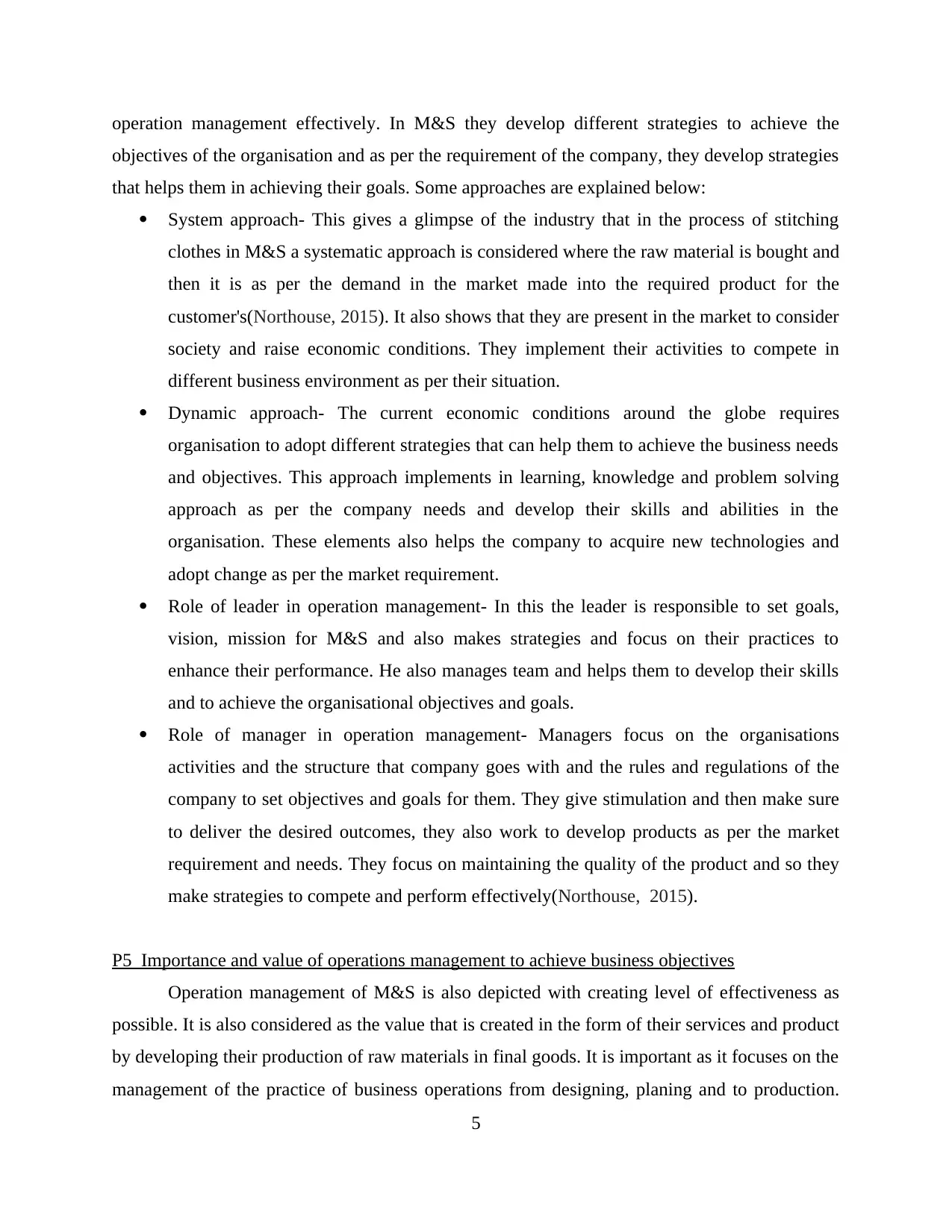
operation management effectively. In M&S they develop different strategies to achieve the
objectives of the organisation and as per the requirement of the company, they develop strategies
that helps them in achieving their goals. Some approaches are explained below:
System approach- This gives a glimpse of the industry that in the process of stitching
clothes in M&S a systematic approach is considered where the raw material is bought and
then it is as per the demand in the market made into the required product for the
customer's(Northouse, 2015). It also shows that they are present in the market to consider
society and raise economic conditions. They implement their activities to compete in
different business environment as per their situation.
Dynamic approach- The current economic conditions around the globe requires
organisation to adopt different strategies that can help them to achieve the business needs
and objectives. This approach implements in learning, knowledge and problem solving
approach as per the company needs and develop their skills and abilities in the
organisation. These elements also helps the company to acquire new technologies and
adopt change as per the market requirement.
Role of leader in operation management- In this the leader is responsible to set goals,
vision, mission for M&S and also makes strategies and focus on their practices to
enhance their performance. He also manages team and helps them to develop their skills
and to achieve the organisational objectives and goals.
Role of manager in operation management- Managers focus on the organisations
activities and the structure that company goes with and the rules and regulations of the
company to set objectives and goals for them. They give stimulation and then make sure
to deliver the desired outcomes, they also work to develop products as per the market
requirement and needs. They focus on maintaining the quality of the product and so they
make strategies to compete and perform effectively(Northouse, 2015).
P5 Importance and value of operations management to achieve business objectives
Operation management of M&S is also depicted with creating level of effectiveness as
possible. It is also considered as the value that is created in the form of their services and product
by developing their production of raw materials in final goods. It is important as it focuses on the
management of the practice of business operations from designing, planing and to production.
5
objectives of the organisation and as per the requirement of the company, they develop strategies
that helps them in achieving their goals. Some approaches are explained below:
System approach- This gives a glimpse of the industry that in the process of stitching
clothes in M&S a systematic approach is considered where the raw material is bought and
then it is as per the demand in the market made into the required product for the
customer's(Northouse, 2015). It also shows that they are present in the market to consider
society and raise economic conditions. They implement their activities to compete in
different business environment as per their situation.
Dynamic approach- The current economic conditions around the globe requires
organisation to adopt different strategies that can help them to achieve the business needs
and objectives. This approach implements in learning, knowledge and problem solving
approach as per the company needs and develop their skills and abilities in the
organisation. These elements also helps the company to acquire new technologies and
adopt change as per the market requirement.
Role of leader in operation management- In this the leader is responsible to set goals,
vision, mission for M&S and also makes strategies and focus on their practices to
enhance their performance. He also manages team and helps them to develop their skills
and to achieve the organisational objectives and goals.
Role of manager in operation management- Managers focus on the organisations
activities and the structure that company goes with and the rules and regulations of the
company to set objectives and goals for them. They give stimulation and then make sure
to deliver the desired outcomes, they also work to develop products as per the market
requirement and needs. They focus on maintaining the quality of the product and so they
make strategies to compete and perform effectively(Northouse, 2015).
P5 Importance and value of operations management to achieve business objectives
Operation management of M&S is also depicted with creating level of effectiveness as
possible. It is also considered as the value that is created in the form of their services and product
by developing their production of raw materials in final goods. It is important as it focuses on the
management of the practice of business operations from designing, planing and to production.
5
Paraphrase This Document
Need a fresh take? Get an instant paraphrase of this document with our AI Paraphraser
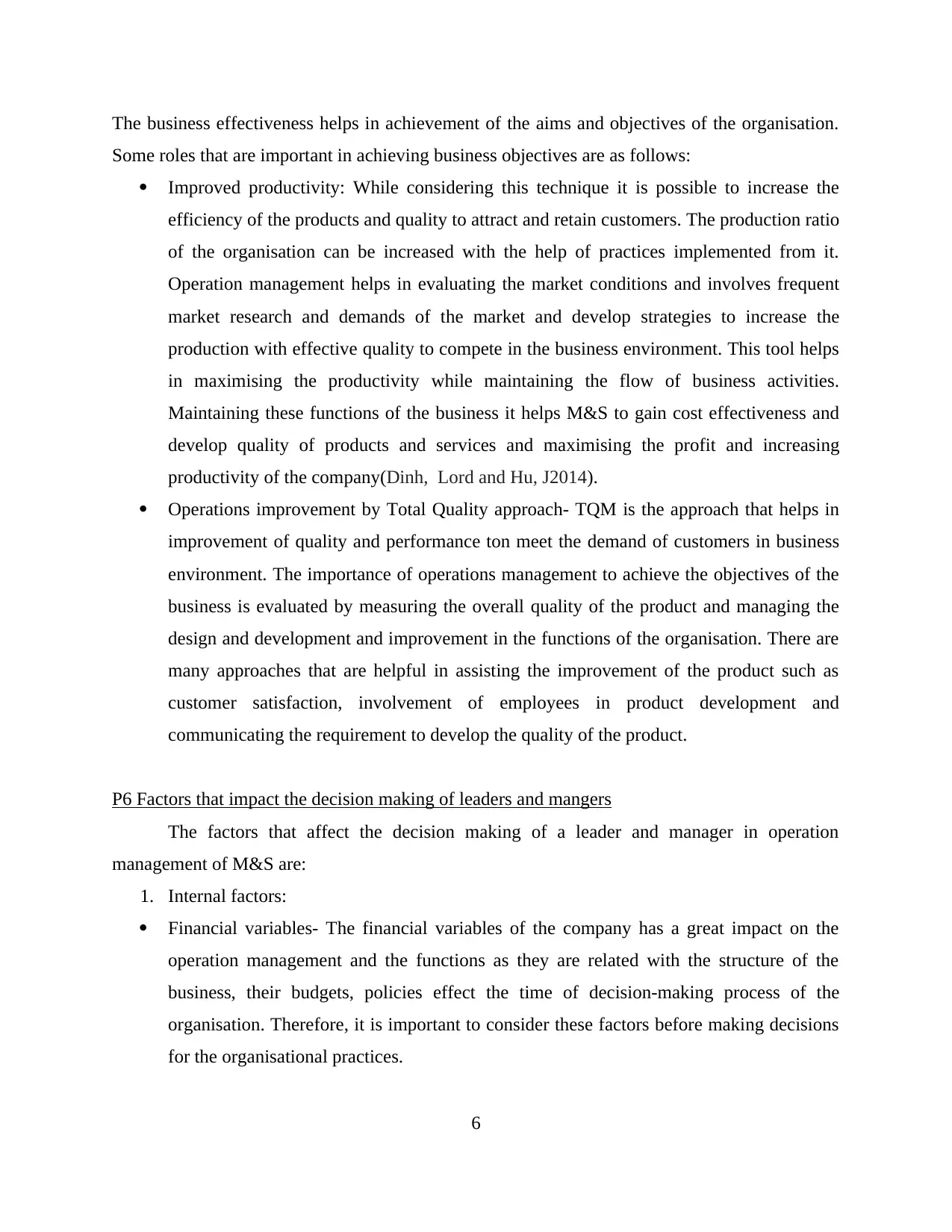
The business effectiveness helps in achievement of the aims and objectives of the organisation.
Some roles that are important in achieving business objectives are as follows:
Improved productivity: While considering this technique it is possible to increase the
efficiency of the products and quality to attract and retain customers. The production ratio
of the organisation can be increased with the help of practices implemented from it.
Operation management helps in evaluating the market conditions and involves frequent
market research and demands of the market and develop strategies to increase the
production with effective quality to compete in the business environment. This tool helps
in maximising the productivity while maintaining the flow of business activities.
Maintaining these functions of the business it helps M&S to gain cost effectiveness and
develop quality of products and services and maximising the profit and increasing
productivity of the company(Dinh, Lord and Hu, J2014).
Operations improvement by Total Quality approach- TQM is the approach that helps in
improvement of quality and performance ton meet the demand of customers in business
environment. The importance of operations management to achieve the objectives of the
business is evaluated by measuring the overall quality of the product and managing the
design and development and improvement in the functions of the organisation. There are
many approaches that are helpful in assisting the improvement of the product such as
customer satisfaction, involvement of employees in product development and
communicating the requirement to develop the quality of the product.
P6 Factors that impact the decision making of leaders and mangers
The factors that affect the decision making of a leader and manager in operation
management of M&S are:
1. Internal factors:
Financial variables- The financial variables of the company has a great impact on the
operation management and the functions as they are related with the structure of the
business, their budgets, policies effect the time of decision-making process of the
organisation. Therefore, it is important to consider these factors before making decisions
for the organisational practices.
6
Some roles that are important in achieving business objectives are as follows:
Improved productivity: While considering this technique it is possible to increase the
efficiency of the products and quality to attract and retain customers. The production ratio
of the organisation can be increased with the help of practices implemented from it.
Operation management helps in evaluating the market conditions and involves frequent
market research and demands of the market and develop strategies to increase the
production with effective quality to compete in the business environment. This tool helps
in maximising the productivity while maintaining the flow of business activities.
Maintaining these functions of the business it helps M&S to gain cost effectiveness and
develop quality of products and services and maximising the profit and increasing
productivity of the company(Dinh, Lord and Hu, J2014).
Operations improvement by Total Quality approach- TQM is the approach that helps in
improvement of quality and performance ton meet the demand of customers in business
environment. The importance of operations management to achieve the objectives of the
business is evaluated by measuring the overall quality of the product and managing the
design and development and improvement in the functions of the organisation. There are
many approaches that are helpful in assisting the improvement of the product such as
customer satisfaction, involvement of employees in product development and
communicating the requirement to develop the quality of the product.
P6 Factors that impact the decision making of leaders and mangers
The factors that affect the decision making of a leader and manager in operation
management of M&S are:
1. Internal factors:
Financial variables- The financial variables of the company has a great impact on the
operation management and the functions as they are related with the structure of the
business, their budgets, policies effect the time of decision-making process of the
organisation. Therefore, it is important to consider these factors before making decisions
for the organisational practices.
6
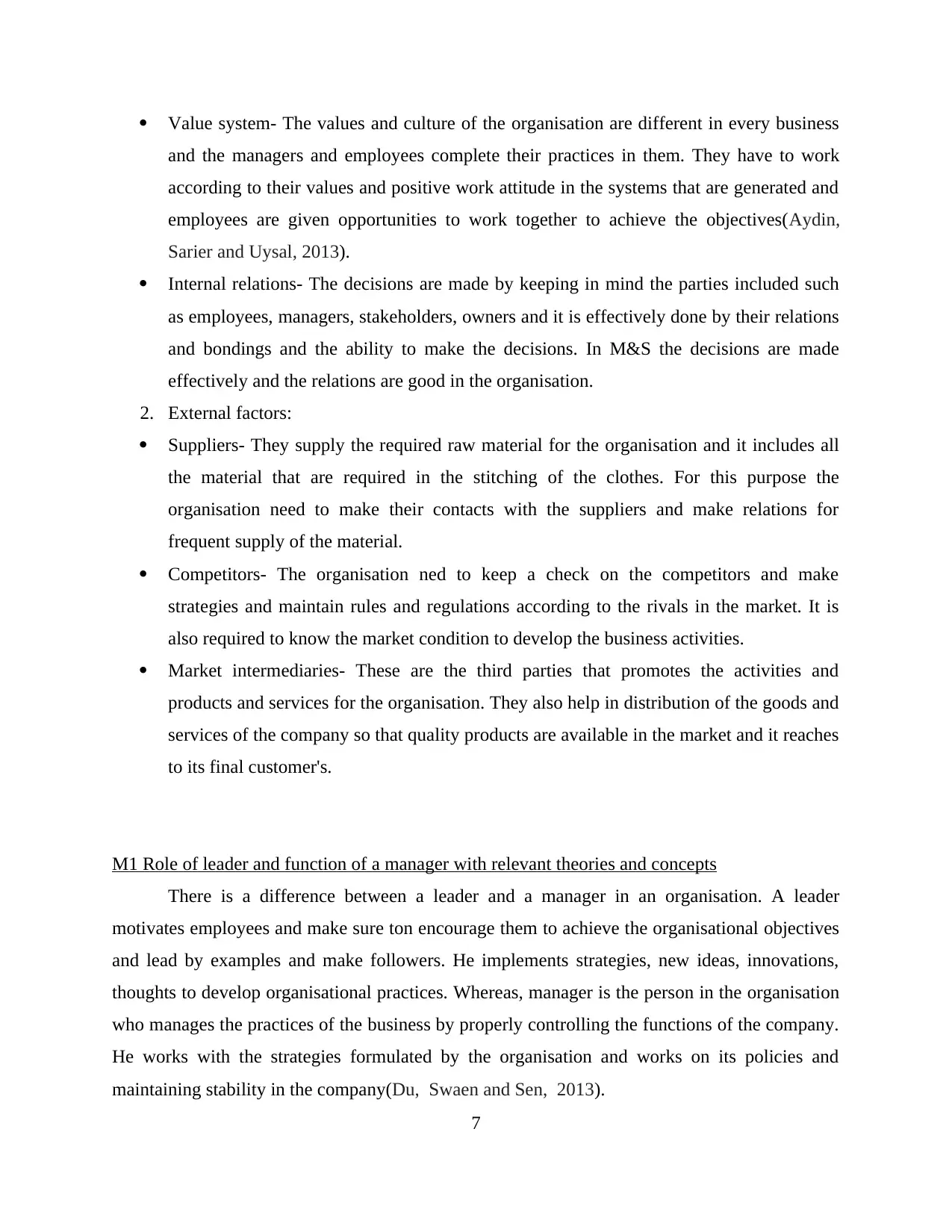
Value system- The values and culture of the organisation are different in every business
and the managers and employees complete their practices in them. They have to work
according to their values and positive work attitude in the systems that are generated and
employees are given opportunities to work together to achieve the objectives(Aydin,
Sarier and Uysal, 2013).
Internal relations- The decisions are made by keeping in mind the parties included such
as employees, managers, stakeholders, owners and it is effectively done by their relations
and bondings and the ability to make the decisions. In M&S the decisions are made
effectively and the relations are good in the organisation.
2. External factors:
Suppliers- They supply the required raw material for the organisation and it includes all
the material that are required in the stitching of the clothes. For this purpose the
organisation need to make their contacts with the suppliers and make relations for
frequent supply of the material.
Competitors- The organisation ned to keep a check on the competitors and make
strategies and maintain rules and regulations according to the rivals in the market. It is
also required to know the market condition to develop the business activities.
Market intermediaries- These are the third parties that promotes the activities and
products and services for the organisation. They also help in distribution of the goods and
services of the company so that quality products are available in the market and it reaches
to its final customer's.
M1 Role of leader and function of a manager with relevant theories and concepts
There is a difference between a leader and a manager in an organisation. A leader
motivates employees and make sure ton encourage them to achieve the organisational objectives
and lead by examples and make followers. He implements strategies, new ideas, innovations,
thoughts to develop organisational practices. Whereas, manager is the person in the organisation
who manages the practices of the business by properly controlling the functions of the company.
He works with the strategies formulated by the organisation and works on its policies and
maintaining stability in the company(Du, Swaen and Sen, 2013).
7
and the managers and employees complete their practices in them. They have to work
according to their values and positive work attitude in the systems that are generated and
employees are given opportunities to work together to achieve the objectives(Aydin,
Sarier and Uysal, 2013).
Internal relations- The decisions are made by keeping in mind the parties included such
as employees, managers, stakeholders, owners and it is effectively done by their relations
and bondings and the ability to make the decisions. In M&S the decisions are made
effectively and the relations are good in the organisation.
2. External factors:
Suppliers- They supply the required raw material for the organisation and it includes all
the material that are required in the stitching of the clothes. For this purpose the
organisation need to make their contacts with the suppliers and make relations for
frequent supply of the material.
Competitors- The organisation ned to keep a check on the competitors and make
strategies and maintain rules and regulations according to the rivals in the market. It is
also required to know the market condition to develop the business activities.
Market intermediaries- These are the third parties that promotes the activities and
products and services for the organisation. They also help in distribution of the goods and
services of the company so that quality products are available in the market and it reaches
to its final customer's.
M1 Role of leader and function of a manager with relevant theories and concepts
There is a difference between a leader and a manager in an organisation. A leader
motivates employees and make sure ton encourage them to achieve the organisational objectives
and lead by examples and make followers. He implements strategies, new ideas, innovations,
thoughts to develop organisational practices. Whereas, manager is the person in the organisation
who manages the practices of the business by properly controlling the functions of the company.
He works with the strategies formulated by the organisation and works on its policies and
maintaining stability in the company(Du, Swaen and Sen, 2013).
7
⊘ This is a preview!⊘
Do you want full access?
Subscribe today to unlock all pages.

Trusted by 1+ million students worldwide
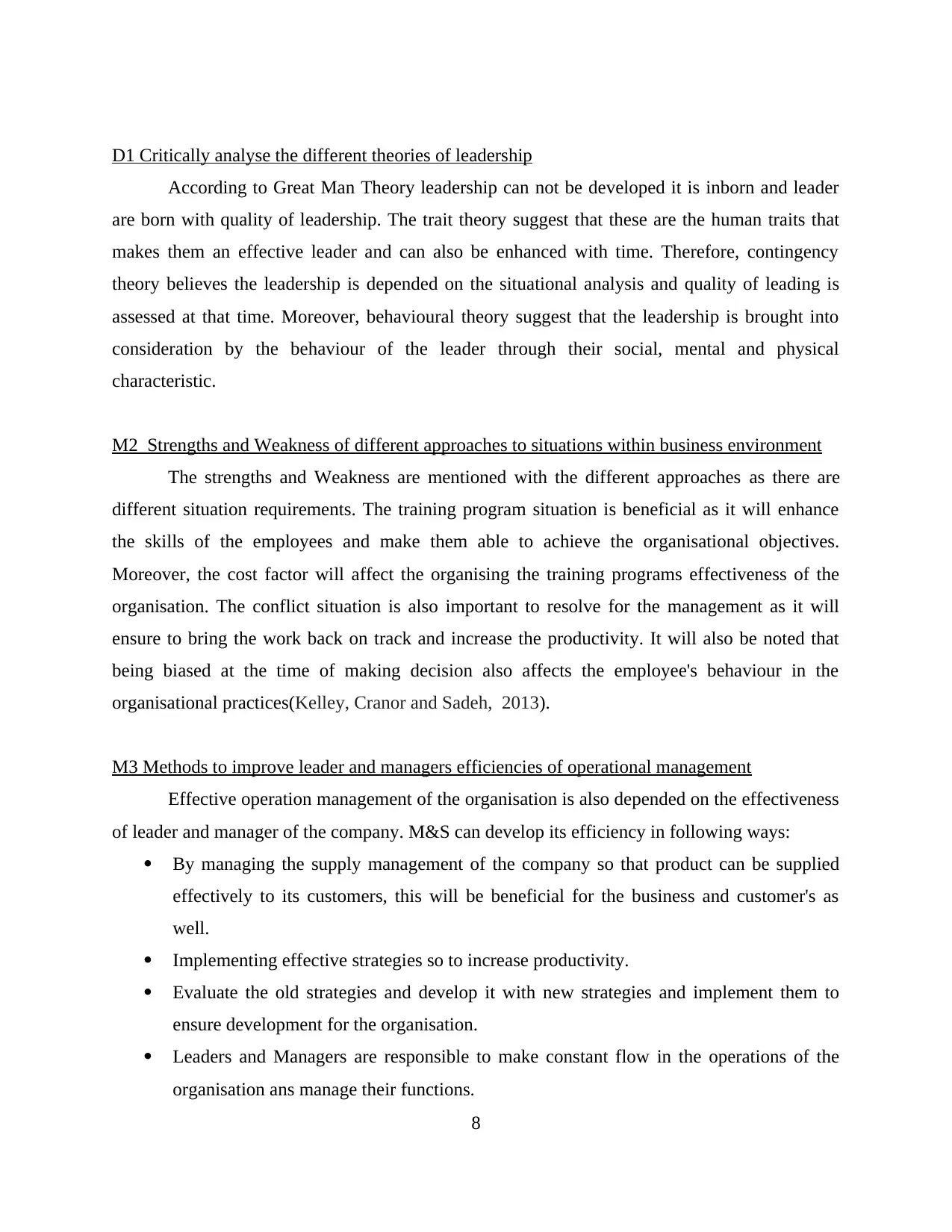
D1 Critically analyse the different theories of leadership
According to Great Man Theory leadership can not be developed it is inborn and leader
are born with quality of leadership. The trait theory suggest that these are the human traits that
makes them an effective leader and can also be enhanced with time. Therefore, contingency
theory believes the leadership is depended on the situational analysis and quality of leading is
assessed at that time. Moreover, behavioural theory suggest that the leadership is brought into
consideration by the behaviour of the leader through their social, mental and physical
characteristic.
M2 Strengths and Weakness of different approaches to situations within business environment
The strengths and Weakness are mentioned with the different approaches as there are
different situation requirements. The training program situation is beneficial as it will enhance
the skills of the employees and make them able to achieve the organisational objectives.
Moreover, the cost factor will affect the organising the training programs effectiveness of the
organisation. The conflict situation is also important to resolve for the management as it will
ensure to bring the work back on track and increase the productivity. It will also be noted that
being biased at the time of making decision also affects the employee's behaviour in the
organisational practices(Kelley, Cranor and Sadeh, 2013).
M3 Methods to improve leader and managers efficiencies of operational management
Effective operation management of the organisation is also depended on the effectiveness
of leader and manager of the company. M&S can develop its efficiency in following ways:
By managing the supply management of the company so that product can be supplied
effectively to its customers, this will be beneficial for the business and customer's as
well.
Implementing effective strategies so to increase productivity.
Evaluate the old strategies and develop it with new strategies and implement them to
ensure development for the organisation.
Leaders and Managers are responsible to make constant flow in the operations of the
organisation ans manage their functions.
8
According to Great Man Theory leadership can not be developed it is inborn and leader
are born with quality of leadership. The trait theory suggest that these are the human traits that
makes them an effective leader and can also be enhanced with time. Therefore, contingency
theory believes the leadership is depended on the situational analysis and quality of leading is
assessed at that time. Moreover, behavioural theory suggest that the leadership is brought into
consideration by the behaviour of the leader through their social, mental and physical
characteristic.
M2 Strengths and Weakness of different approaches to situations within business environment
The strengths and Weakness are mentioned with the different approaches as there are
different situation requirements. The training program situation is beneficial as it will enhance
the skills of the employees and make them able to achieve the organisational objectives.
Moreover, the cost factor will affect the organising the training programs effectiveness of the
organisation. The conflict situation is also important to resolve for the management as it will
ensure to bring the work back on track and increase the productivity. It will also be noted that
being biased at the time of making decision also affects the employee's behaviour in the
organisational practices(Kelley, Cranor and Sadeh, 2013).
M3 Methods to improve leader and managers efficiencies of operational management
Effective operation management of the organisation is also depended on the effectiveness
of leader and manager of the company. M&S can develop its efficiency in following ways:
By managing the supply management of the company so that product can be supplied
effectively to its customers, this will be beneficial for the business and customer's as
well.
Implementing effective strategies so to increase productivity.
Evaluate the old strategies and develop it with new strategies and implement them to
ensure development for the organisation.
Leaders and Managers are responsible to make constant flow in the operations of the
organisation ans manage their functions.
8
Paraphrase This Document
Need a fresh take? Get an instant paraphrase of this document with our AI Paraphraser
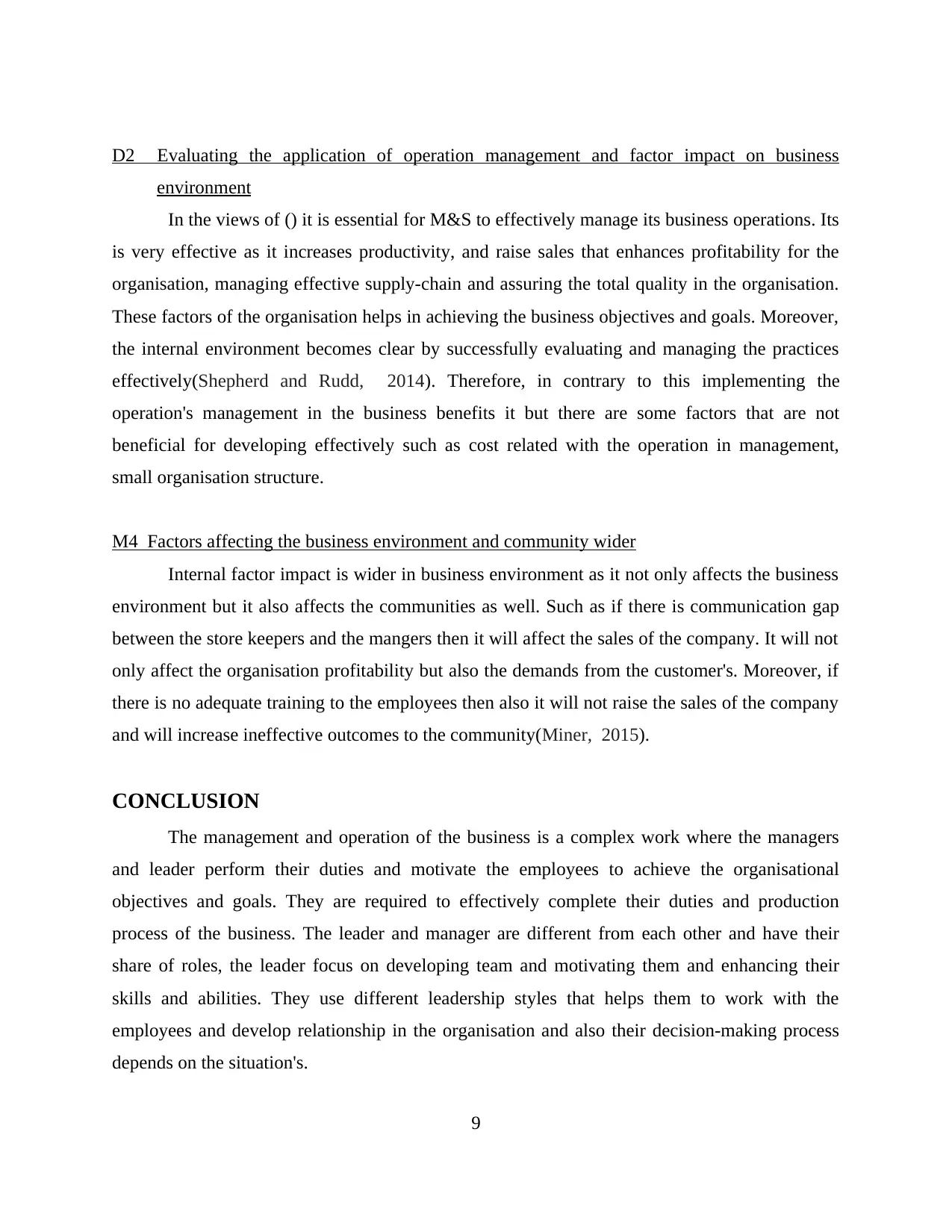
D2 Evaluating the application of operation management and factor impact on business
environment
In the views of () it is essential for M&S to effectively manage its business operations. Its
is very effective as it increases productivity, and raise sales that enhances profitability for the
organisation, managing effective supply-chain and assuring the total quality in the organisation.
These factors of the organisation helps in achieving the business objectives and goals. Moreover,
the internal environment becomes clear by successfully evaluating and managing the practices
effectively(Shepherd and Rudd, 2014). Therefore, in contrary to this implementing the
operation's management in the business benefits it but there are some factors that are not
beneficial for developing effectively such as cost related with the operation in management,
small organisation structure.
M4 Factors affecting the business environment and community wider
Internal factor impact is wider in business environment as it not only affects the business
environment but it also affects the communities as well. Such as if there is communication gap
between the store keepers and the mangers then it will affect the sales of the company. It will not
only affect the organisation profitability but also the demands from the customer's. Moreover, if
there is no adequate training to the employees then also it will not raise the sales of the company
and will increase ineffective outcomes to the community(Miner, 2015).
CONCLUSION
The management and operation of the business is a complex work where the managers
and leader perform their duties and motivate the employees to achieve the organisational
objectives and goals. They are required to effectively complete their duties and production
process of the business. The leader and manager are different from each other and have their
share of roles, the leader focus on developing team and motivating them and enhancing their
skills and abilities. They use different leadership styles that helps them to work with the
employees and develop relationship in the organisation and also their decision-making process
depends on the situation's.
9
environment
In the views of () it is essential for M&S to effectively manage its business operations. Its
is very effective as it increases productivity, and raise sales that enhances profitability for the
organisation, managing effective supply-chain and assuring the total quality in the organisation.
These factors of the organisation helps in achieving the business objectives and goals. Moreover,
the internal environment becomes clear by successfully evaluating and managing the practices
effectively(Shepherd and Rudd, 2014). Therefore, in contrary to this implementing the
operation's management in the business benefits it but there are some factors that are not
beneficial for developing effectively such as cost related with the operation in management,
small organisation structure.
M4 Factors affecting the business environment and community wider
Internal factor impact is wider in business environment as it not only affects the business
environment but it also affects the communities as well. Such as if there is communication gap
between the store keepers and the mangers then it will affect the sales of the company. It will not
only affect the organisation profitability but also the demands from the customer's. Moreover, if
there is no adequate training to the employees then also it will not raise the sales of the company
and will increase ineffective outcomes to the community(Miner, 2015).
CONCLUSION
The management and operation of the business is a complex work where the managers
and leader perform their duties and motivate the employees to achieve the organisational
objectives and goals. They are required to effectively complete their duties and production
process of the business. The leader and manager are different from each other and have their
share of roles, the leader focus on developing team and motivating them and enhancing their
skills and abilities. They use different leadership styles that helps them to work with the
employees and develop relationship in the organisation and also their decision-making process
depends on the situation's.
9
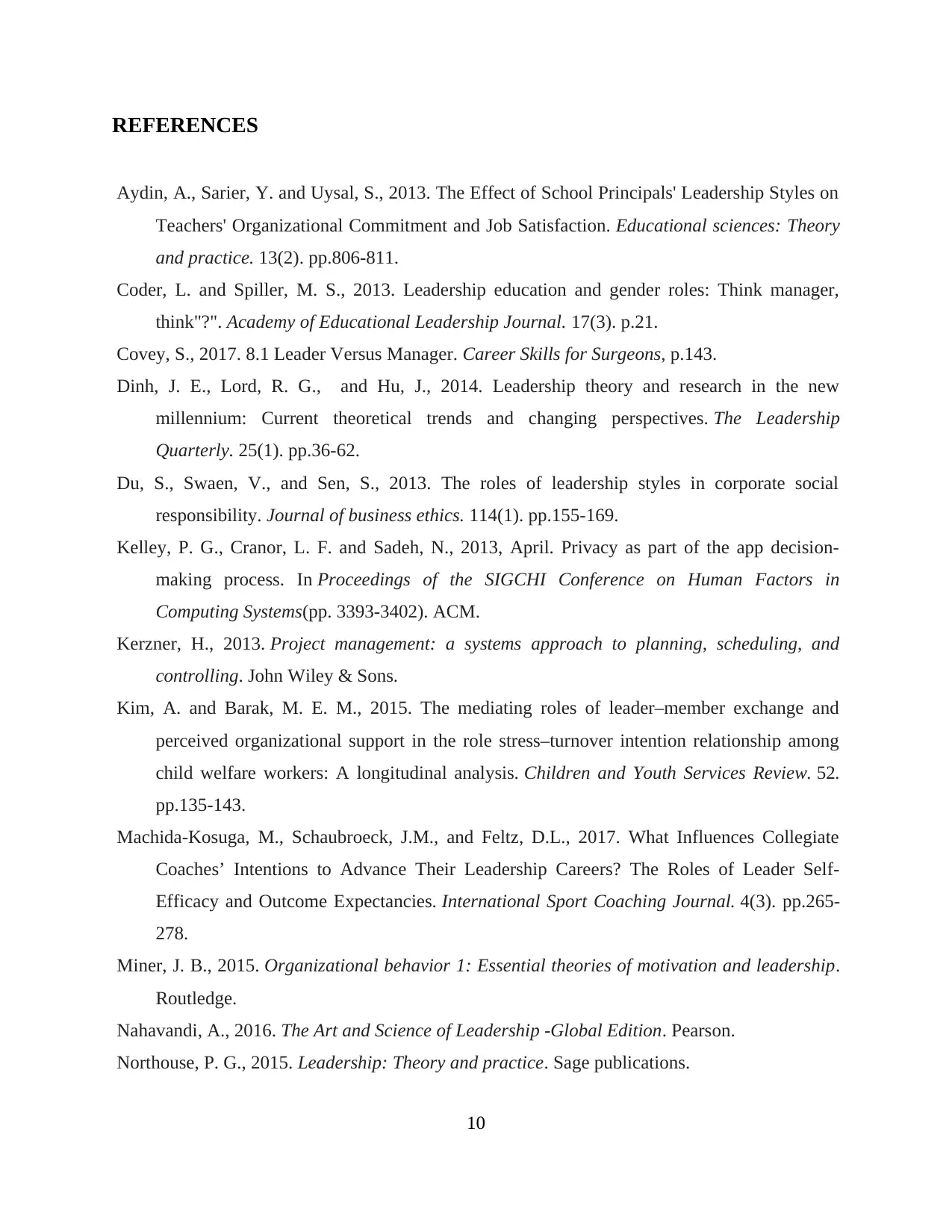
REFERENCES
Aydin, A., Sarier, Y. and Uysal, S., 2013. The Effect of School Principals' Leadership Styles on
Teachers' Organizational Commitment and Job Satisfaction. Educational sciences: Theory
and practice. 13(2). pp.806-811.
Coder, L. and Spiller, M. S., 2013. Leadership education and gender roles: Think manager,
think"?". Academy of Educational Leadership Journal. 17(3). p.21.
Covey, S., 2017. 8.1 Leader Versus Manager. Career Skills for Surgeons, p.143.
Dinh, J. E., Lord, R. G., and Hu, J., 2014. Leadership theory and research in the new
millennium: Current theoretical trends and changing perspectives. The Leadership
Quarterly. 25(1). pp.36-62.
Du, S., Swaen, V., and Sen, S., 2013. The roles of leadership styles in corporate social
responsibility. Journal of business ethics. 114(1). pp.155-169.
Kelley, P. G., Cranor, L. F. and Sadeh, N., 2013, April. Privacy as part of the app decision-
making process. In Proceedings of the SIGCHI Conference on Human Factors in
Computing Systems(pp. 3393-3402). ACM.
Kerzner, H., 2013. Project management: a systems approach to planning, scheduling, and
controlling. John Wiley & Sons.
Kim, A. and Barak, M. E. M., 2015. The mediating roles of leader–member exchange and
perceived organizational support in the role stress–turnover intention relationship among
child welfare workers: A longitudinal analysis. Children and Youth Services Review. 52.
pp.135-143.
Machida-Kosuga, M., Schaubroeck, J.M., and Feltz, D.L., 2017. What Influences Collegiate
Coaches’ Intentions to Advance Their Leadership Careers? The Roles of Leader Self-
Efficacy and Outcome Expectancies. International Sport Coaching Journal. 4(3). pp.265-
278.
Miner, J. B., 2015. Organizational behavior 1: Essential theories of motivation and leadership.
Routledge.
Nahavandi, A., 2016. The Art and Science of Leadership -Global Edition. Pearson.
Northouse, P. G., 2015. Leadership: Theory and practice. Sage publications.
10
Aydin, A., Sarier, Y. and Uysal, S., 2013. The Effect of School Principals' Leadership Styles on
Teachers' Organizational Commitment and Job Satisfaction. Educational sciences: Theory
and practice. 13(2). pp.806-811.
Coder, L. and Spiller, M. S., 2013. Leadership education and gender roles: Think manager,
think"?". Academy of Educational Leadership Journal. 17(3). p.21.
Covey, S., 2017. 8.1 Leader Versus Manager. Career Skills for Surgeons, p.143.
Dinh, J. E., Lord, R. G., and Hu, J., 2014. Leadership theory and research in the new
millennium: Current theoretical trends and changing perspectives. The Leadership
Quarterly. 25(1). pp.36-62.
Du, S., Swaen, V., and Sen, S., 2013. The roles of leadership styles in corporate social
responsibility. Journal of business ethics. 114(1). pp.155-169.
Kelley, P. G., Cranor, L. F. and Sadeh, N., 2013, April. Privacy as part of the app decision-
making process. In Proceedings of the SIGCHI Conference on Human Factors in
Computing Systems(pp. 3393-3402). ACM.
Kerzner, H., 2013. Project management: a systems approach to planning, scheduling, and
controlling. John Wiley & Sons.
Kim, A. and Barak, M. E. M., 2015. The mediating roles of leader–member exchange and
perceived organizational support in the role stress–turnover intention relationship among
child welfare workers: A longitudinal analysis. Children and Youth Services Review. 52.
pp.135-143.
Machida-Kosuga, M., Schaubroeck, J.M., and Feltz, D.L., 2017. What Influences Collegiate
Coaches’ Intentions to Advance Their Leadership Careers? The Roles of Leader Self-
Efficacy and Outcome Expectancies. International Sport Coaching Journal. 4(3). pp.265-
278.
Miner, J. B., 2015. Organizational behavior 1: Essential theories of motivation and leadership.
Routledge.
Nahavandi, A., 2016. The Art and Science of Leadership -Global Edition. Pearson.
Northouse, P. G., 2015. Leadership: Theory and practice. Sage publications.
10
⊘ This is a preview!⊘
Do you want full access?
Subscribe today to unlock all pages.

Trusted by 1+ million students worldwide
1 out of 13
Related Documents
Your All-in-One AI-Powered Toolkit for Academic Success.
+13062052269
info@desklib.com
Available 24*7 on WhatsApp / Email
![[object Object]](/_next/static/media/star-bottom.7253800d.svg)
Unlock your academic potential
Copyright © 2020–2025 A2Z Services. All Rights Reserved. Developed and managed by ZUCOL.





